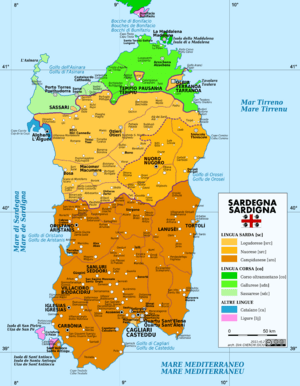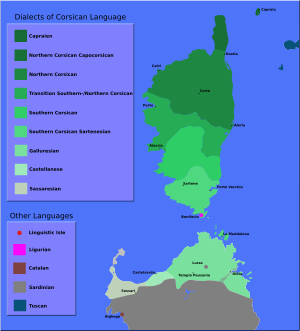Gallurese facts for kids
Quick facts for kids Gallurese |
|
|---|---|
| gadduresu | |
| Pronunciation | IPA: [ɡaɖːuˈrezu] |
| Native to | Italy |
| Region | Gallura (northern Sardinia) |
| Ethnicity | Corsicans Sardinians |
| Native speakers | 100,000 (1999)e19 |
| Language family | |
| Recognised minority language in | |
| Linguasphere | 51-AAA-pd |

Languages and dialects of Sardinia
|
|
Gallurese (called gadduresu by its speakers) is a special language spoken in Gallura, a region in northeastern Sardinia, Italy. It belongs to the Romance language family, just like Italian and Spanish.
Many people debate if Gallurese is a type of Corsican language or a language that mixes both Corsican and Sardinian. It shares many words and grammar rules with southern Corsican dialects, especially those from Sartene and Porto-Vecchio in Corsica. However, its sounds and sentence structure are more like Sardinian. About one-third of Gallurese words also come from Logudorese Sardinian, Catalan, and Spanish.
Every year, there's a special event called "Gallurese International Day" (Ciurrata Internaziunali di la Linga Gadduresa) in Palau, Sardinia. People from Corsica and other areas join in to celebrate the language.
The Sassarese dialect, spoken near Sassari, is another language that mixes different influences. It's a blend of Tuscan, Corsican, and Sardinian, but it's generally closer to Sardinian dialects than Gallurese is.
Contents
History of Gallurese
The oldest writings in Gallurese date back to the early 1600s. These were mostly poems and religious songs. Some older pieces of writing suggest the language might have started forming around the early 1400s.
Experts like Max Leopold Wagner and Maurice Le Lannou believe that Gallurese developed because many people moved from southern Corsica to Sardinia. This happened when the Aragonese rulers encouraged people to resettle the area, which had been badly affected by hunger and sickness. These migrations helped create this unique language.
What Makes Gallurese Special?
Gallurese has some interesting features that make it stand out:
- Plural Nouns: Nouns in Gallurese often end in -i when they are plural (meaning more than one), like ghjanni or polti (meaning 'doors'). This is similar to Corsican and Italian, but different from Sardinian, French, or Spanish, which often use -s.
- Sounds like -dd-: The Latin 'll' sound changed to -dd- in Gallurese, such as in casteddu ('castle') and coraddu ('coral'). This is like southern Corsican, Sardinian, and Sicilian.
- r to l change: Sometimes, the 'r' sound changes to 'l', for example, poltu ('port'). In Corsican and Sardinian, it's usually portu.
- Special Sounds: Gallurese uses -chj- and -ghj- sounds, like in ghjesgia ('church') and occhji ('eyes'). These are also found in Corsican, but Sardinian uses different sounds like cresia and ogros.
- Articles: It uses lu, la, li for words like 'the'. These were common in old Corsican dialects. Modern Corsican uses u, a, i, while Sardinian uses su, sa, sos, sas.
How Gallurese Relates to Corsican
Some language experts say Gallurese is a dialect of Corsican, while others say it's a dialect of Sardinian. However, Gallurese is very similar to Southern Corsican dialects. It's less similar to the nearby Sardinian languages.
A linguist named Mauro Maxia explained in 2014 that Gallurese can be seen as a mix:
- Its sounds and grammar are mostly like Corsican.
- Its sentence structure is mostly like Sardinian.
- Its words are mostly like Corsican, but it has many words from Sardinian, Catalan, and Spanish. These borrowed words make up about one-third of all its words.
He concluded that Gallurese is a "transitional language." This means it acts as a bridge between Corsican and Sardinian.
The Regional Government of Sardinia has officially recognized Gallurese, along with Sassarese, as separate languages. They are seen as distinct from Sardinian.
A Sample of Gallurese
Here is a small part of a hymn (a religious song) dedicated to the Virgin Mary. You can see how Gallurese compares to other languages in the region.
| Standard Italian | Southern Corsican | Gallurese | Sassarese | Logudorese Sardinian | English translation |
|---|---|---|---|---|---|
|
Tu sei nata per incanto |
Tù sè nata par incantu |
Tu sei nata par incantu |
Tu sei nadda pà incantu |
Tue ses naschida pro incantu |
You were born of enchantment |
See also
 In Spanish: Gallurés para niños
In Spanish: Gallurés para niños


